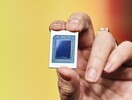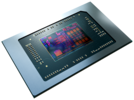AMD Ryzen 9 PRO 6950H vs AMD Ryzen 7 H 260 vs AMD Ryzen 7 PRO 8840HS
AMD Ryzen 9 PRO 6950H
► remove from comparison
The AMD Ryzen 9 PRO 6950H is a processor for big (workstation) laptops based on the Rembrandt generation. The R9 6900HX integrates all eight cores based on the Zen 3+ microarchitecture. They are clocked at 3.3 (guaranteed base clock) to 4.9 GHz (Turbo) and support SMT / Hyperthreading (16 threads). The chip is manufactured on the modern 6 nm TSMC process. The 6950H is the professional version of the consumer R9 6900HX without overclocking features but with additional management features and the Microsoft Pluton Security processor.
The new Zen 3+ architecture is a refresh of the Zen 3 architecture and should not offer a lot of changes. The chip itself however, offers a lot of new features, like support for USB 4 (40 Gbps), PCI-E Gen 4, DDR5-4800MT/s or LPDDR5-6400MT/s, WiFi 6E, Bluetooth LE 5.2, DisplayPort 2, and AV1 decode.
A big novelty is the integrated GPU Radeon 680M, that is now based on the RDNA2 architecture and offers 12 CUs at up to 2.4 GHz. It should be the fastest iGPU of all at the time of announcement.
Performance
While we have not tested a single system built around the 6950H as of August 2023, we have tested one system featuring the 6950HS, its slightly more power-efficient brother. Based on that, expect the 6950H to be slightly faster than the Ryzen 7 5800H, Ryzen 9 4900H, Ryzen 5 PRO 7640HS and also the Core i7-11800H. In other words, this is a higher-end chip that will handle almost any task with ease, as of late 2022.
Your mileage may vary depending on how competent the cooling solution of your laptop is and how high the CPU power limits are.
Power consumption
This Ryzen has a default TDP of 45 W (also known as the PL1). A high-performance cooling solution is a must for a CPU like this one here.
Ryzen 9 PRO 6950H is built with TSMC's 6 nm process leading to great, as of late 2022, energy efficiency.
AMD Ryzen 7 H 260
► remove from comparison
The AMD Ryzen 7 H 260 is a high-end notebook processor from the Hawk Point series with 8 cores and hyperthreading (SMT), which means it can process up to 16 threads simultaneously. At release, the CPU is only available in China and is technically practically identical to the older AMD Ryzen 7 8845HS or Ryzen 7 7840HS (slower AI engine).
The performance of the second-fastest model in the Hawk Point series should only be slightly behind the Ryzen 9 7940HS (+100 - 200 MHz clock, e.g. only 2% slower Turbo). As a result, the performance at 54W TDP should also be comparable to the AMD Ryzen 7 7745HX (also 8 Zen 4 cores, max 5.1 GHz, 55W, 32 MB L3) and thus clearly ahead of the old top model AMD Ryzen 9 6980HX resp. 6980HS (with lower TDP).
The chip integrates a modern RDNA 3-based graphics card (iGPU) called Radeon 780M with 12 CUs and up to 2.7GHz including AV1 video engine. Furthermore, a Xilinx FPGA-based XDNA AI accelerator is also integrated, which is now clocked higher. Hawk Point offers 2x USB 4 (40 Gbps), 20 PCIe 4.0 lanes and a dual-channel DDR5-5600 / LPDDR5x-7500 memory controller (with ECC support).
The Hawk Point series is a single chip (unlike the Dragon Range 7045HX series) and is manufactured at TSMC using the modern 4nm FinFET process.
AMD Ryzen 7 PRO 8840HS
► remove from comparison
The Ryzen 7 PRO 8840HS is a powerful processor (APU) of the Hawk Point family. This isn't an entirely new laptop chip; instead, it's a rebadged Ryzen 7 7840U with a slightly higher wattage as well as higher clock speeds on the Ryzen AI NPU. The 8840HS has eight Zen 4 cores running at 3.3 GHz to 5.1 GHz that are SMT-enabled for a total of 16 processing threads, while the great Radeon 780M is responsible for 3D processing and similar duties. Compared to the consumer 8840HS, the PRO variant supports AMD PRO technologies with management features and usually longer availability and support.
Architecture & Features
Hawk Point family chips are powered by the Zen 4 architecture, much like Phoenix and Dragon Range family chips are. That's not to say there is no difference between the three. With Hawk Point, AMD is betting big on generative AI; these processors are set to deliver an up to 40% increase in generative AI performance over 7040 series APUs, making apps like DaVinci Resolve and Adobe Photoshop more useful than ever before.
Unlike Zen 3, Zen 4 features AVX512 support and, thanks to a plethora of other improvements including larger caches/registers/buffers, is slated to bring a double-digit IPC improvement over the former.
Elsewhere, the R7 PRO 8840HS has 16 MB of L3 cache and support for super-fast DDR5-5600 and LPDDR5x-7500 RAM. The chip is compatible with USB 4 and therefore with Thunderbolt. It comes with 20 PCIe 4 lanes, giving NVMe SSDs up to 7.8 GB/s of throughput.
Systems built around this Ryzen 7 series APU are designed to run 64-bit Windows 11, 64-bit Windows 10, or Linux. Please note that this processor is not overclockable and neither is it user-replaceable. It gets soldered down for good instead (FP7, FP7r2, FP8 socket interfaces).
Performance
Since this is a 7840U in disguise that we are dealing with here, it is safe to expect the 8840HS to be about as fast as the Core i7-12650H, as far as multi-thread performance is concerned.
Your mileage may vary depending on how high the CPU power limits are, and how competent the cooling solution of your laptop is.
Graphics
The Radeon 780M has 12 CUs (768 shaders) purring away at up to 2,700 MHz. This is exactly the right iGPU for people looking for a bit more horsepower than what Intel's aging Xe options can provide. The Radeon will let you use up to 4 monitors with resolutions as high as SUHD 4320p and it will also HW-decode and HW-encode the most widely used video codecs (including AV1, HEVC and AVC) without breaking a sweat. In terms of gaming, the thing is good enough for 1080p and medium-to-low settings, as of late 2023.
Your mileage may vary depending on how high the CPU power limits are, how competent the cooling solution of your system is, how fast the RAM of your system is (there is no dedicated VRAM here).
Power consumption
This Ryzen 7 series chip has a long-term power limit (default TDP) of 28 W that laptop makers are free to tune to their liking, with values between 20 W and 30 W greenlighted by AMD. Either way, an active cooling solution is a must for any system powered by this chip.
The 8840HS is built with TSMC's 4 nm process for high, as of late 2023, energy efficiency.
| Model | AMD Ryzen 9 PRO 6950H | AMD Ryzen 7 H 260 | AMD Ryzen 7 PRO 8840HS | ||||||||||||||||||||||||||||||||||||||||||||||||||||||||||||||||||||||||||||||||||||||||||||||||||||||||||||||||||||||||||||||||||||||||||||
| Codename | Rembrandt-H (Zen 3+) | Hawk Point-HS (Zen 4) | Hawk Point-HS (Zen 4) | ||||||||||||||||||||||||||||||||||||||||||||||||||||||||||||||||||||||||||||||||||||||||||||||||||||||||||||||||||||||||||||||||||||||||||||
| Series | AMD Rembrandt (Zen 3+) | AMD Hawk Point (Zen 4/4c) | AMD Hawk Point (Zen 4/4c) | ||||||||||||||||||||||||||||||||||||||||||||||||||||||||||||||||||||||||||||||||||||||||||||||||||||||||||||||||||||||||||||||||||||||||||||
| Series: Hawk Point (Zen 4/4c) Hawk Point-HS (Zen 4) |
|
|
| ||||||||||||||||||||||||||||||||||||||||||||||||||||||||||||||||||||||||||||||||||||||||||||||||||||||||||||||||||||||||||||||||||||||||||||
| Clock | 3300 - 4900 MHz | 3800 - 5100 MHz | 3300 - 5100 MHz | ||||||||||||||||||||||||||||||||||||||||||||||||||||||||||||||||||||||||||||||||||||||||||||||||||||||||||||||||||||||||||||||||||||||||||||
| L2 Cache | 4 MB | 8 MB | 8 MB | ||||||||||||||||||||||||||||||||||||||||||||||||||||||||||||||||||||||||||||||||||||||||||||||||||||||||||||||||||||||||||||||||||||||||||||
| L3 Cache | 16 MB | 16 MB | 16 MB | ||||||||||||||||||||||||||||||||||||||||||||||||||||||||||||||||||||||||||||||||||||||||||||||||||||||||||||||||||||||||||||||||||||||||||||
| Cores / Threads | 8 / 16 | 8 / 16 8 x 5.1 GHz AMD Zen 4 | 8 / 16 8 x 5.1 GHz AMD Zen 4 | ||||||||||||||||||||||||||||||||||||||||||||||||||||||||||||||||||||||||||||||||||||||||||||||||||||||||||||||||||||||||||||||||||||||||||||
| TDP | 45 Watt | 45 Watt | 28 Watt | ||||||||||||||||||||||||||||||||||||||||||||||||||||||||||||||||||||||||||||||||||||||||||||||||||||||||||||||||||||||||||||||||||||||||||||
| Technology | 6 nm | 4 nm | 4 nm | ||||||||||||||||||||||||||||||||||||||||||||||||||||||||||||||||||||||||||||||||||||||||||||||||||||||||||||||||||||||||||||||||||||||||||||
| max. Temp. | 95 °C | 100 °C | 100 °C | ||||||||||||||||||||||||||||||||||||||||||||||||||||||||||||||||||||||||||||||||||||||||||||||||||||||||||||||||||||||||||||||||||||||||||||
| Socket | FP7/FP7r2 | FP7/FP7r2/FP8 | FP7/FP7r2/FP8 | ||||||||||||||||||||||||||||||||||||||||||||||||||||||||||||||||||||||||||||||||||||||||||||||||||||||||||||||||||||||||||||||||||||||||||||
| Features | DDR5-4800/LPDDR5-6400 RAM (incl. ECC), PCIe 4, PRO, MMX, SSE, SSE2, SSE3, SSSE3, SSE4A, SSE4.1, SSE4.2, AVX, AVX2, BMI2, ABM, FMA, ADX, SMEP, SMAP, SMT, CPB, AES-NI, RDRAND, RDSEED, SHA, SME | DDR5-5600/LPDDR5x-7500 RAM, PCIe 4, Ryzen AI, MMX, SSE, SSE2, SSE3, SSSE3, SSE4A, SSE4.1, SSE4.2, AVX, AVX2, AVX-512, BMI2, ABM, FMA, ADX, SMEP, SMAP, SMT, CPB, AES-NI, RDRAND, RDSEED, SHA, SME | DDR5-5600/LPDDR5x-7500 RAM, PCIe 4, Ryzen AI, AES, AVX, AVX2, AVX512, FMA3, MMX (+), SHA, SSE, SSE2, SSE3, SSE4.1, SSE4.2, SSE4A, SSSE3 | ||||||||||||||||||||||||||||||||||||||||||||||||||||||||||||||||||||||||||||||||||||||||||||||||||||||||||||||||||||||||||||||||||||||||||||
| iGPU | AMD Radeon 680M ( - 2400 MHz) | AMD Radeon 780M ( - 2700 MHz) | AMD Radeon 780M ( - 2700 MHz) | ||||||||||||||||||||||||||||||||||||||||||||||||||||||||||||||||||||||||||||||||||||||||||||||||||||||||||||||||||||||||||||||||||||||||||||
| Architecture | x86 | x86 | x86 | ||||||||||||||||||||||||||||||||||||||||||||||||||||||||||||||||||||||||||||||||||||||||||||||||||||||||||||||||||||||||||||||||||||||||||||
| Announced | |||||||||||||||||||||||||||||||||||||||||||||||||||||||||||||||||||||||||||||||||||||||||||||||||||||||||||||||||||||||||||||||||||||||||||||||
| Manufacturer | www.amd.com | www.amd.com | www.amd.com | ||||||||||||||||||||||||||||||||||||||||||||||||||||||||||||||||||||||||||||||||||||||||||||||||||||||||||||||||||||||||||||||||||||||||||||
| L1 Cache | 512 KB | 512 KB | |||||||||||||||||||||||||||||||||||||||||||||||||||||||||||||||||||||||||||||||||||||||||||||||||||||||||||||||||||||||||||||||||||||||||||||
| Die Size | 178 mm2 | 178 mm2 |
Benchmarks
Average Benchmarks AMD Ryzen 9 PRO 6950H → 0% n=0
Average Benchmarks AMD Ryzen 7 PRO 8840HS → 0% n=0
* Smaller numbers mean a higher performance
1 This benchmark is not used for the average calculation












